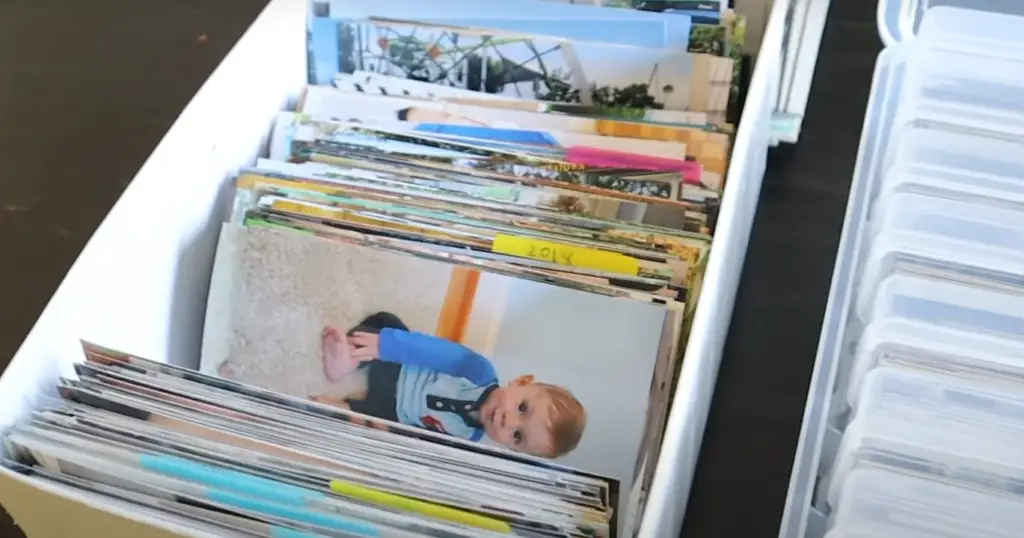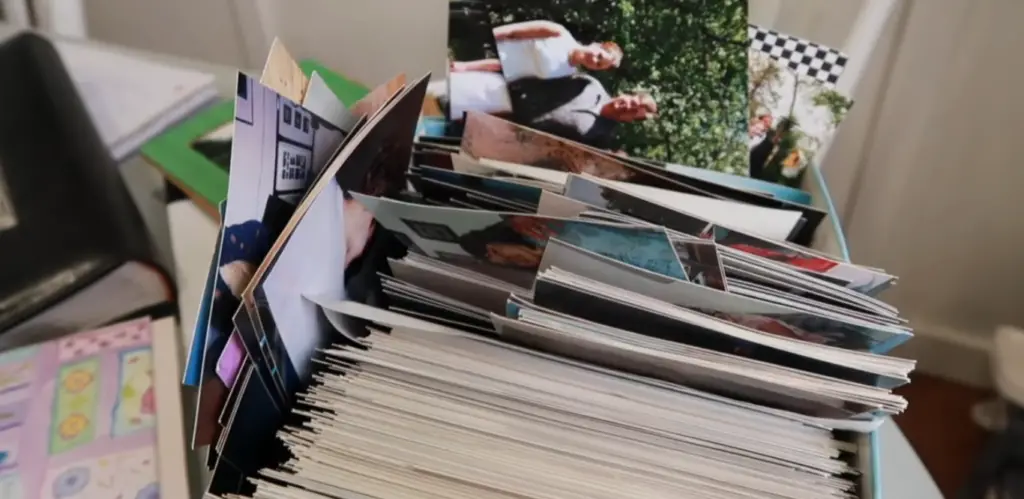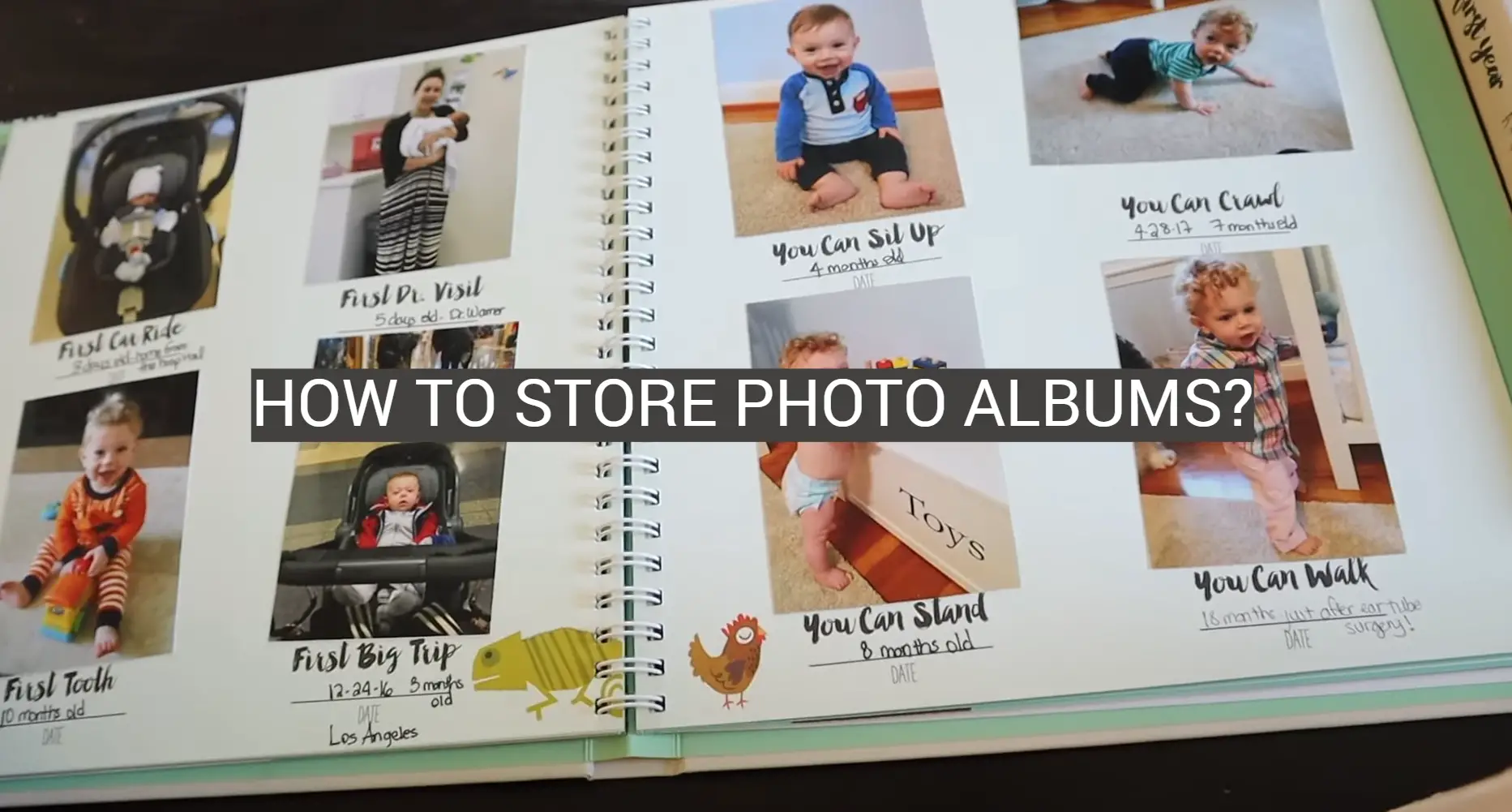Do you have a ton of photo albums taking up space in your closet? Are you tired of sorting through them every time you want to show your friends or family a picture from your trip to Hawaii? If so, it’s time to learn how to store photo albums properly! In this article, we will provide tips and advice on how to store photo albums so that they are easy to find and access when you need them.
Focus on print quality
Not only will this make sure that your pictures look their best when stored away, but it will also help them last longer and age better over time. Look for photo albums that have archival-quality paper with a neutral pH balance, as well as acid-free backing pages to protect the photos from fading or discoloration. If possible, consider printing on both sides of the page so you can double up on storage space. Photo albums come in all types of materials, so make sure to choose one that fits your needs and budget.

Once you’ve chosen the right album for your photos, the next step is to organize them properly. Start by sorting through your pictures and grouping them according to event or date. This will not only make it easier for you to find specific photos when you need them, but it also gives more of a story-like feel as you go through the album chronologically. Once all the photos have been sorted, start labeling each page with dates and descriptions so that you know exactly what each photo contains.
Use an archival-quality box or album
When choosing a box or album, look for one that is labeled “archival quality.” This means the material used to make it won’t be acidic and will protect your photos from discoloration and fading. Look for an album with a sturdy cover, strong binding, and acid-free pages.
You may also want to consider an album with a protective slipcover or dust jacket. This can help protect your photos from dirt and dust, which can cause them to become brittle over time.
Include a safe index card
When you are storing photographs in albums, make sure that you include a safe index card somewhere in the album. This will help you to keep track of where each photo is located so that when it comes time to look for them, you can easily find what you need. Make sure that the card is clearly labeled and easy to read so that when someone looks at your albums they can quickly understand what picture goes where. Additionally, if any of your photos get lost or damaged, having an index card can be useful in helping you remember what was on the page before.
Write with a No. 2 pencil
This will help ensure that the labels stay legible and visible over time. Sharpie pens can fade or wear off after long periods of storage, so avoid these when possible. You also may want to consider adding a few extra words onto your labels so that if part of it rubs off, there is still enough information to identify the photo.

Location counts
Areas with high humidity or moisture can cause the photos to become discolored and moldy, so make sure that you avoid these areas as much as possible. Consider using a container with an airtight seal or choosing a storage space away from windows or vents where temperature and humidity fluctuate frequently. Additionally, if you have several albums, make sure that they are stored separately from each other so that their pages do not stick together due to moisture build-up. [1]
How to Save Your Family Photo Albums
Your family photo albums are a treasure trove of precious memories. But unfortunately, these albums have a limited lifespan and can easily be damaged if they are not properly cared for. If you want to ensure that your photo albums survive through the generations, it’s important to learn how to store them correctly.
First things first: let’s start with finding an appropriate storage space or container for all your beloved photos! You should ideally select a dry area that is moisture-free and out of direct sunlight – this will help preserve the quality of your pictures and prevent fading. Something like an attic or closet is ideal; simply make sure there is adequate ventilation so any excess humidity won’t accumulate onto the photos.
Once you’ve picked the right place, it’s time to start organizing. Look for containers that are acid-free, lignin-free and PVC-free. These boxes can be purchased from most office supply stores or online retailers. Consider the size of your albums when selecting a box – make sure it’s wide enough to fit them all in comfortably without having to squeeze them together or fold pages over.
And when it comes to separating your photo albums, opt for acid-free tissue paper as a protective layer between each album. This especially applies if you plan to stack them on top of one another! And lastly, make sure you add labels onto each container so you know where everything is stored at a glance.
Lock in freshness
In the long run, a simple storage box is not enough to protect your albums from environmental factors. To really keep your photos safe and secure, you should consider investing in a climate-controlled environment such as an archival quality filing cabinet or dehumidifier unit. These units can help regulate temperature and humidity levels so that any excess moisture is removed from the air – ensuring that your photos will stay in top condition for years to come!
Beware of old albums
If you’re lucky enough to have albums that are decades old, there’s one extra step you’ll need to take when it comes to preserving them. Over time, the pages of older albums can become fragile and prone to tearing – so it’s vital that each page is handled with great care. When looking through an album, try not to move too quickly or turn too many pages at once; instead, slowly flip through each one so as not to add any unnecessary stress onto the paper.

Your family photo albums are irreplaceable memories; make sure they last a lifetime by learning how to store them correctly! A few simple steps will go a long way in preserving these precious books – and keeping your memories safe for years to come.
Remove stuck photos (if you can)
If you can, gently remove the photos from the album before storing them. If the photos are stuck, use a thin blade to carefully slip between the photo and page to separate it. Then, use a soft cloth with archival-safe materials like lint-free cotton or even microfiber to lightly wipe away any residue that may be left behind.
It’s also important to avoid using adhesive removal products when trying to remove stubborn photos. Many of these products contain chemicals that could damage your photos beyond repair. Addressing individual stuck areas with an eraser is another option – just make sure you don’t rub too hard so as not to damage the surface of the photo itself.
Jot down details
When it comes to preserving your photo albums, you should start by writing down the details of each one. This will help you stay organized and ensure that any photos included in an album can be identified easily. For example, if an album contains a particular wedding or vacation, note it down with the date so you know exactly what each album is about.
Create a digital backup
Digital backups are a great way to ensure that your photos are safe and secure no matter what happens to the physical copies. You can create digital backups of your photos in many ways. You can use cloud storage services like Dropbox, Google Photos, or iCloud; you can also use external hard drives, USB flash drives, or even CD/DVDs. Once you’ve created a digital backup, you’ll be able to access it from anywhere with an internet connection. Just make sure that your backup is stored securely and regularly backed up itself so that all of your data is kept safe!
Compile your photos in a safe album
Once you’ve printed out your photos, it’s time to store them in a safe album. You can opt for traditional photo albums or modern digital ones — whichever suits your needs best.
Traditional albums are great for anyone who loves having tangible copies of their memories handy at all times, sharing with friends and family, or just looking back fondly on special moments in life. When choosing an album, decide which type will best suit your needs: from books that lay flat like scrapbooks to standard-bound albums. Choose one that is acid-free and lignin-free as these materials help ensure that the colors of your prints won’t fade over time. Before placing any photos into an album, use archival sleeves or sheet protectors to keep them safe from dirt, dust and damage.

Digital photo albums are great because they make it easy to back up your photos, plus they save storage space in your home. You can also quickly access them online wherever you are — even share them with family and friends. To create a digital album, simply upload all of your printed photos onto your computer or use an app like Google Photos, iCloud Photos, Amazon Prime Photos, Microsoft OneDrive and more. Be sure to store the original files in multiple places for backup purposes too — just in case something happens to the first set of files. As for sharing images with others, always be mindful of the quality when you’re sending over small versions of your photos, as they will not retain the same quality when printed out.
Box up photos for safekeeping
When choosing a storage box, make sure it’s acid-free and archival quality so your photos won’t be damaged over time. Label the outside of the box with its contents for easy retrieval later on. Try to store your photos lying flat or standing up, depending on the photo album size and available space.
If you don’t have enough room to fit all your photo albums into one box, consider using multiple boxes or getting some plastic bins instead. Plastic bins are great because they come in various sizes, are water-resistant and stack easily on top of each other. Just remember to label them properly so you know exactly what’s inside!
Once your photos are safely stored away, it’s a good idea to take an inventory of them. Writing down the title and location of each box in a spreadsheet or document can help you monitor which boxes you have on hand and where they’re located. This will make it easier to find specific photos when you need them in the future.

Finally, store your photo albums in a cool, dry place that is free from moisture and dust. Make sure any containers they’re stored in the airtight so no moisture or dirt can get inside the box and damage your photos over time. And if possible, consider keeping them off the floor or ground by storing them on shelves instead.
Make albums accessible
Organizing your photo albums doesn’t have to be complicated. One popular way to keep them in order is to make them easily accessible when you want a trip down memory lane. Consider storing all of your albums in a single location, like a bookshelf or designated drawer, so they can be found quickly and easily whenever you need them. You can even create an index with the titles of each album, as well as its contents, for reference and use this index to label the spines of each album.
You may also want to consider labeling individual photos within albums for easier retrieval; this could include the date taken, people featured in the photo, and any other notes that will help jog your memory when looking through the collection.
Frame a few
Sometimes, it can be nice to have a few select photos from an album on display in your home. To do this, you’ll want to transfer them into frames for preservation and to avoid any damage that could occur when repeatedly handling and opening the album. You may even decide to hang some of these framed photos in a gallery wall as art! [2]
If you’re feeling creative, consider making scrapbooks with your pictures or enlarging/envisioning prints featuring your favorite shots. This ensures they stay safe while also allowing your personality to shine through.

FAQ
Where should you store photo albums?
The best place to store photo albums is somewhere cool, dark, and dry. You want to avoid areas that fluctuate in temperature or humidity. This could potentially cause warping or fading of the album’s pages, as well as damage to any photographs stored inside. Some ideal places include attics, basements, and closets that are not frequently accessed. If you find yourself needing more space than what your home has to offer, consider renting a storage unit designed specifically for storing photos and other mementos. [3]
Should photo albums be stored upright or flat?
It depends on what type of photo album you’re storing. For standard photo albums, it’s generally best to keep them stored upright. This will help keep the pages from warping or bending over time. However, if you have a professional book-style album with thicker pages and a hard binding, then it should be safe to store either way. Just make sure that whatever direction you choose, the albums are kept away from any direct sunlight or heat sources that could cause damage. [4]
It’s also important to consider your storage space when deciding how to store your albums. If space is limited and you need to maximize capacity, flat storage may be the way to go since uprights take up more room than laying albums down side by side.
Is it OK to store photo albums in plastic bins?
Yes, it is perfectly OK to store your photo albums in plastic bins. In fact, this is one of the most common and cost-effective ways to store them. It’s important that the bin you choose has airtight lids so that your pictures won’t be exposed to humidity or dirt. If you have more than a few albums, make sure you label them clearly with their contents. Keep in mind that if you plan on keeping these items for years, it’s best to invest in acid-free bins as they will better protect your photos from fading over time. [5]
Keeping your photos organized within each bin can also be beneficial by color coding the album covers. This way when it comes to retrieving them, you’ll know exactly which bin to look in.
If the price point is an issue for you, cardboard boxes are always a good alternative as they are also airtight and can provide adequate protection for your photos as long as the box isn’t too big or too heavy. Just be sure that if you use cardboard you buy acid-free ones that won’t leach chemicals onto your photos.
No matter what type of storage container you decide on, make sure it has handles on each side so it’s easy to transport should the need arise. It’s also wise to take some extra precautionary steps by wrapping each album in tissue paper or bubble wrap before putting it into the bin or box. This will give added protection and help prevent your photos from becoming scratched or damaged over time.
Finally, it’s best to store your albums in a cool, dry place in order to ensure that they stay intact for many years. With proper care and storage techniques, you can keep your photo albums safe and sound for years to come!
What do I do with all my photo albums?
If you’re like most of us, you probably have a few boxes full of photo albums that need to be stored and preserved for years to come. Whether it’s your own family photos or those from an ancestor, there are a few things you can do to make sure your memories last.
The first thing to consider is how much space you have available for storage. If space is limited, try using smaller albums or plastic sleeves instead of bulky books. This will help keep the albums organized and prevent them from becoming damaged. It’s also important that the albums are kept in a dry place away from direct sunlight as this can cause fading over time.
Another way to store your precious memories is to digitize them. Scanning your albums and saving the images as digital files can be a great way to keep them safe without taking up any extra space. This also allows you to easily share these photos with family and friends around the world.
If you choose not to digitize, another great solution is using acid-free paper sleeves or boxes that have been designed specifically for photo albums. These will protect the photos from dust and dirt while still allowing them to be displayed nicely in an album or frame.
Finally, if you’re looking for a more permanent storage solution, consider investing in an archival quality box or cabinet. These are designed specifically to store photo albums and art prints safely, making sure they are well-protected from moisture and air.
Whatever option you choose, make sure to store your photo albums in a way that will ensure their longevity. Taking the time to insure proper storage now can help preserve your memories for many years to come!
Useful Video: SIMPLE PHOTO ORGANIZATION TIPS!
Conclusion
Storing photo albums can be a daunting task, but it doesn’t have to be. There are several simple steps you can take to make the process easier and ensure your precious memories are kept safe for years to come. First, decide how and where you want to store your photos—in an album, on a computer, or in the cloud. Then choose a storage option that best suits your needs and budget. Finally, don’t forget to label each photo so you can easily find what you need when you need it! With these tips in mind, your photo albums will be organized and preserved for many years of enjoyment. So get started today!
References
- https://www.nytimes.com/wirecutter/blog/store-print-photographs/
- https://www.houzz.com/magazine/how-to-save-your-family-photo-albums-stsetivw-vs~82510382
- https://www.nytimes.com/wirecutter/blog/store-print-photographs/
- https://www.nedcc.org/preservation101/session-5/5-storing-photograph-collections
- https://www.castorage.com/blog/how-to-store-photos-in-a-storage-unit/












Leave a Reply